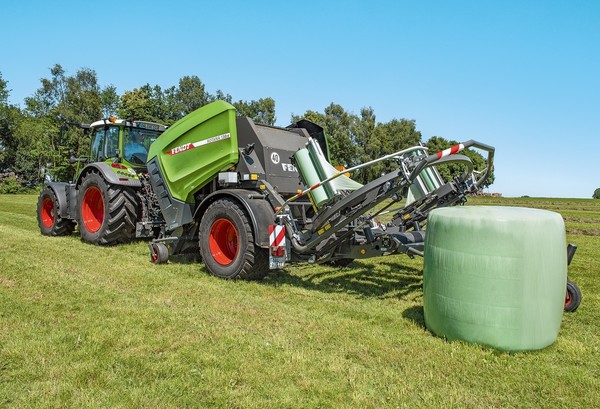
Roto-balers, a refined technology
Roto-balers represent an advanced technology, characterized by great reliability, simplicity and manageability. This type of machine is versatile now more than ever, with a vast choice of models, suitable for all types of forage and for every farm size
The structural changes that have recently characterized roto-balers have undoubtedly significantly increased their efficiency, with tangible benefits also in terms of productivity. The main design distinction concerns the forage loading chamber, which can be variable or fixed volume. As the name suggests, in the fixed-chamber models the incoming product passes from the pick-up to the pressing chamber very quickly, making a bale with a “soft core”, i.e. with an internal compression level that is definitely lower than the external part. Otherwise, the bales that form in a baler with a variable volume chamber are characterized by having a “hard core”, i.e. with a constant density, thanks to the belts (or other containment parts) that widen as the forage enters the chamber, maintaining a constant pressure during the entire formation of the cylindrical bale.
The spread of the packaging of delicate grass hays, such as hay wheat and alfalfa, has led some manufacturers to develop models for packaging soft core round bales without compression, so as to minimize any mechanical damage, and consequently any losses. In other situations, and in particular when the product is collected semi-hayed and then wrapped with plastic film (to create and maintain appropriate anaerobic conditions), the possibility of making bales of varying sizes is offered. In this way, as the herd is being fed daily, it is possible to consume the entire single round bales at once and without unwanted leftovers, resulting in a higher quality of the food.
In detail, it is a rocker mechanism, programmable from the driver’s seat to pre-set the bale diameter, between just 50 and 165 cm in diameter. The most appropriate dimension can be defined based on the type of forage and its water content, so that the species with higher added value, such as the alfalfa, can be packaged at a lower pressure.
The blades
More and more often a blade rotor is available as an option to shred the incoming product, be it hay or straw. It is a preventive processing that ensures better digestibility (for forage), and greater manoeuvrability of the litter (for straw).
The blades, which can be inserted or retracted according to need, exert their action thanks to a contrasting rotor above, placed immediately downstream of the pick-up, and equipped with a series of pairs of star-shaped teeth mounted at a fixed distance one from the other, on staggered ranks and often with a helical layout. The management of blades, their periodic sharpening and the possible replacement have been greatly facilitated on the most recent models. It is also possible to select the density, so as to define a priori the length of the product fragments entering the compression chamber.
On the subject, Krone offers the Xcut solution, which on models with a 2.15 m wide pick-up can work with devices from 17 to 26 blades, selectable in various combinations (26, but also 17, 15 or only 7) from the driving seat with a simple command.
The blade edge is corrugated and curved, so as to increase the length of the blade edge, in order to maximize contact with the material and optimize cutting, which takes place by traction, but minimizing the demand for power, thus containing the tractor’s diesel consumption. The blades are all the same in order to guarantee interchangeability. Their replacement (for damage or wear) is possible through a centralized control that loosens the springs that hold them in position and allows their subsequent removal, with extraction from the top. In addition, each compressing spring acts as a protection on the corresponding blade in the event of accidental contact with blunt objects, such as stones or rocks picked up by the pick-up.
In practice, the blade retracts towards the fixing base, automatically returning to the working position, thanks to the subsequent distension of the spring.
Binding and wrapping
The binding of the bale, a phase of the task that has always been particularly delicate, must be simple and reliable: users in this situation require excellent performance, speed of action and uniformity in cutting the material used for packaging.
Considering the normal working speeds, usually between 6 and 9 km/h (but sometimes with peaks up to 15 km/h ...), the limiting factor for productivity is represented by the binding itself.
From this point of view, the process is considerably improved by being able to visually monitor the operation of the binding device from the driver’s seat, using the monitor that equips high end models.
The regularity of the formation, both in terms of pressure applied to the incoming product and the size of the bale, are now further indispensable factors for the successful management of the subsequent transport and storage phases.
Moreover, when in the field it is necessary to replace the twine or net spool used for tying, another important aspect is that of being able to work at eye level, to avoid unnecessary efforts due to lifting the roll.
Due to increasingly productive models, the reels have taken on a considerable size (and therefore weight) in order to guarantee an appropriate autonomy as well as the need for adequate space on board for placing the technical stock. Among the options for forage management, wrapping is an option that can follow the binding.
The evolution of this operation is the merging of the two operations in a single machine, i.e. baling-wrapping machines, which can also work simultaneously. In essence, while a bale is formed, the previous one is wrapped, saving a lot of time on the single routine, which is beneficial above all in adverse weather conditions, where the timeliness of the task is vital.
In the wrapping phase, through the terminal installed on the tractor it is extremely useful to be able to program the number of layers of film to overlap, as well as the speed of rotation of the pick-up and that of the exhaust system. An addition feature on the more recent models is unloading on the ground of the banded bale, which turns out to be particularly delicate, precisely to avoid damaging the plastic film that would create ways for oxygen to enter the forage mass, triggering dangerous aerobic fermentation processes.
In the event that wrapping is not necessary, an interesting option is the option for the tied bale to stop for a short time in the wrapping area, so that two bales can be unloaded at the same time, further optimizing the collection time.
The electronic control terminal is now a “must” on all modern round balers, to be able to accurately and continuously monitor the main work parameters, including the pressure applied to the forage entering the pressing chamber, the number of layers of plastic film to be overlaid, as well as of course the operation of the various hydraulic solenoid valves by dedicated sensors. Last but not least, the implementation of diagnostics and IsoBUS compatibility, which offer a further qualitative leap for productivity and work quality.
The lift, a fundametal element
The lift is the structure that allows the bale to take the typically cylindrical shape. It is characterized by bars, belts, chains and rollers, driven by rotors and gears, which constitute the moving external part of the pressing chamber, and which, by rotating, ensure that the material takes on a circular movement during the formation and subsequent binding, and that it is finally expelled easily when the chamber is opened.
It is therefore a fundamental part of the roto-baler, built with sturdy and wear-resistant materials, ideally maintenance-free and with a surface finish to ensure the maximum smoothness of the product inside.
Among the many solutions offered by the market, we note Krone's Novogrip, consisting of a structure with metal bars and rubberised fabric straps, which help to form well-pressed bales and which is well suited to all types of forage, from dry hay to straw, up to silage forages with very high humidity levels.








